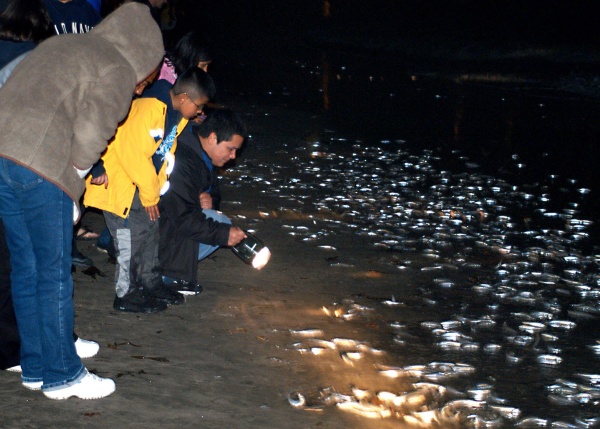Photo credit: Gary Florin, CMA. Used with permission.
While a weekend in Barbados watching mama sea turtles lay eggs in the beach sand DOES sound pretty darn nice, Southlanders don’t need to travel far to experience a sea creatures exiting the water with the purpose of procreation. The Southern California Grunion Run is a bona fide rite of passage and an annual event that celebrates that slippery silver fish that has found beach sand the perfect incubator.
Officially known as Lerestes tenuis, the genus and species of grunion that is found off our coastline is a true Southern Californian. According to Larry Fukuhara of the Cabrillo Marine Aquarium, our SoCal grunion range from Santa Barbara to Baja, Mexico. “We don’t know for certain how far off in the ocean coast they dwell, but we estimate that they stick around 4-5 miles off the coast and maybe go down as far as 60 feet,” he says.
Grunion Nights are signature programs at the Cabrillo Marine Aquarium which has been introducing the fishy behavior to kids, families and non-believers for a bazillion years. Adults who came to the nighttime program as children are now bringing their kids to share the wide-eyed experience.
Right now is the height of grunion love. Typically, grunions find their way to shore from about March through August, but April and May are peak periods for these 5-7 inch long fishies. Most of the time, grunion are in “open season” meaning that if you have a fishing license, you are within your God-given rights to scoop, catch and fry up as many of the scaly (and extremely slippery) beasts as you can. April and May, however, is “closed season” which gives the fish time to really get down to mating and egg-laying business.
Many Californians or transplants may find the whole grunion business a hoax, a joke, something akin to “hunting for snipes.” But rest assured, grunion and alive and kicking…with a good emphasis on the kicking.
Grunion can be, after all, somewhat elusive, but they have a method to their madness. They come to shore only 3-4 days after a full or new moon. With their flexible bodies, females burrow backwards in the sand about 2-3 inches. Males approach and wrap their bodies around her to mate – or milt as it’s called for grunion – and then females lay eggs. Lots of them. 1-3,000 eggs. And this is all done in a matter of 10-15 seconds.
“Females can lay eggs about six times a season,” says Fukuhara. “Males can mate every chance they get.”
Sounds about right.
In the sand, grunion eggs are bright orange and full of yolk which dissipates as the young fish develop. Nine days later, you can see baby fish inside the eggs and 12 days later, they are ready for sea living, and unlike baby sea turtles, they don’t have to get to the water on their own accord; they hitch a ride to the surf. AS IF IT WERE PLANNED – and we’re sure it has been – when the fish are viable for water, the high tide grabs them, shakes ‘em up and releases them from their eggs. Talk about timing!
Cabrillo Marine Aquarium offers upcoming Grunion Run Nights including an all-around big bash celebration, a FISH-TAVIL on Saturday, May 11, 2013 starting at 8 p.m. (Doors open at 7pm). Watch a grunion video, hatch an actual grunion, make arts and crafts and, when the time is right, head over to the beach to watch the little flip-floppers. Can’t make that night?
Other Meet the Grunion Nights for 2013 are slated for 8 p.m. March 29, April 12, June 10 and 24, July 10 and 23. (Admission to Fish-tival and Meet the Grunion program is a mere $5 adult, $1 senior, student and child. Bring flashlights and blankets.)
If you want a grunion experience that’s closer to your home beach than driving to San Pedro, Fukuhara says that ALL California beaches are potential grunion beaches. The best beaches for grunion watching, however, are empty ones; apparently grunions react to vibrations like the pitter pat of many feet on the sand. They aren’t too hip on bright lights flashing either. The quieter and more remote a beach, the better.
We sure like the idea of snuggling up to a honey in the dark and watching nature do its thing under starry skies. Cue the Barry White CD, will ya?
— Brenda Rees, editor


